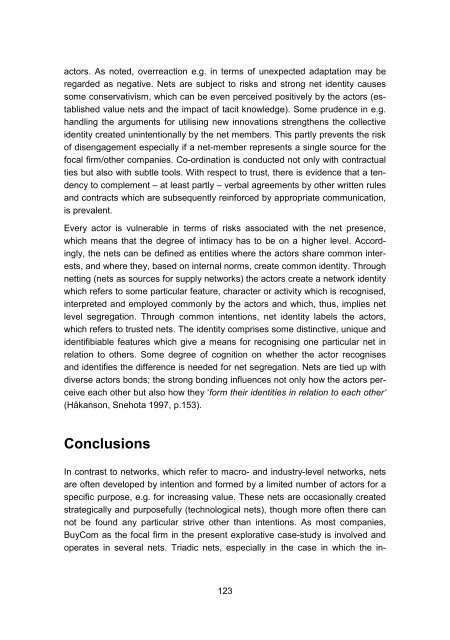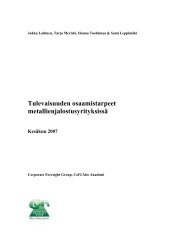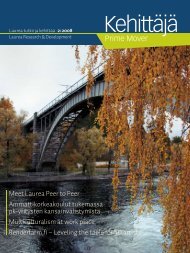849954 sisus
849954 sisus
849954 sisus
Create successful ePaper yourself
Turn your PDF publications into a flip-book with our unique Google optimized e-Paper software.
actors. As noted, overreaction e.g. in terms of unexpected adaptation may be<br />
regarded as negative. Nets are subject to risks and strong net identity causes<br />
some conservativism, which can be even perceived positively by the actors (established<br />
value nets and the impact of tacit knowledge). Some prudence in e.g.<br />
handling the arguments for utilising new innovations strengthens the collective<br />
identity created unintentionally by the net members. This partly prevents the risk<br />
of disengagement especially if a net-member represents a single source for the<br />
focal firm/other companies. Co-ordination is conducted not only with contractual<br />
ties but also with subtle tools. With respect to trust, there is evidence that a tendency<br />
to complement – at least partly – verbal agreements by other written rules<br />
and contracts which are subsequently reinforced by appropriate communication,<br />
is prevalent.<br />
Every actor is vulnerable in terms of risks associated with the net presence,<br />
which means that the degree of intimacy has to be on a higher level. Accordingly,<br />
the nets can be defined as entities where the actors share common interests,<br />
and where they, based on internal norms, create common identity. Through<br />
netting (nets as sources for supply networks) the actors create a network identity<br />
which refers to some particular feature, character or activity which is recognised,<br />
interpreted and employed commonly by the actors and which, thus, implies net<br />
level segregation. Through common intentions, net identity labels the actors,<br />
which refers to trusted nets. The identity comprises some distinctive, unique and<br />
identifibiable features which give a means for recognising one particular net in<br />
relation to others. Some degree of cognition on whether the actor recognises<br />
and identifies the difference is needed for net segregation. Nets are tied up with<br />
diverse actors bonds; the strong bonding influences not only how the actors perceive<br />
each other but also how they ‘form their identities in relation to each other‘<br />
(Håkanson, Snehota 1997, p.153).<br />
Conclusions<br />
In contrast to networks, which refer to macro- and industry-level networks, nets<br />
are often developed by intention and formed by a limited number of actors for a<br />
specific purpose, e.g. for increasing value. These nets are occasionally created<br />
strategically and purposefully (technological nets), though more often there can<br />
not be found any particular strive other than intentions. As most companies,<br />
BuyCom as the focal firm in the present explorative case-study is involved and<br />
operates in several nets. Triadic nets, especially in the case in which the in-<br />
123








